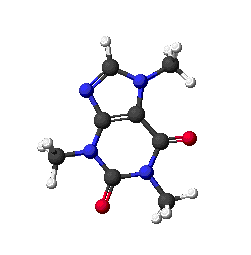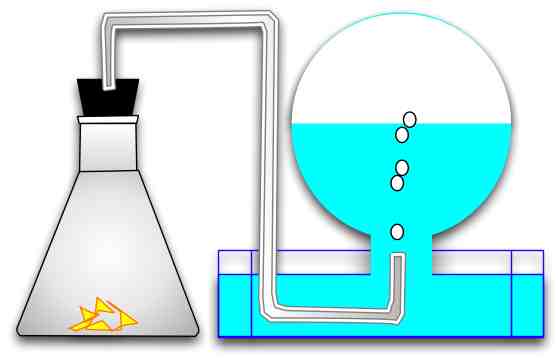
Chemistry
Chemistry 10: 4-8

WebLecture
The Ideal Gas Law: Applications and Exceptions
Outline
Real Gas Behaviors
So far, we have considered ideal situations: pure gases, behaving like tiny billiard balls. Now we are going look more closely at the real situation, and take into account some of the adjustments we need to make to the Ideal Gas Law when we are dealing with mixtures of gases, molecules which aren't point masses, and which may have electrical charges that affect their interaction.
Mixtures of Gases: Partial Pressures
John Dalton was able to observe that when two gases are mixed in the same container (and therefore at the same temperature and volume), the total pressure is equal to the sum of the individual pressures exerted by each gas separately. It is as though neither gas interacts with the other at all. If the total pressure is the sum of individual pressures, then the total pressure depends on the amounts of each gas present. Any pressure differences are dependent on a difference in amounts of the gases.
Many gases are prepared by techniques which release them in aqueous solutions, so that water vapor is present as well as the gas being prepared. There is a relationship between the amount of vapor above any liquid (not just water) and the temperature. In a lab situation, you would look up vapor pressure in a reference book; for our purposes, the reference book is Appendix E. Check it out: the vapor pressure (in torr) of water is given in varying increments for the range of temperatures between -10 and 110 degrees Celsius.
Take a look at the lab setup below. A gas-producing reaction in the Erlenmeyer flask sends gas molecules through the tube submerged in the pneumatic trough and into the inverted, liquid-filled collection flask.

As the collection continues, the gas displaces the water in the inverted flask. We can measure the amount of water displaced and determine the volume of the gas. When the water level stops moving, the reaction is over, and the pressure inside the inverted flask is equal to the pressure outside the flask. By measuring the current barometric pressure, we can determine the pressure inside the flask. With pressure and volume and a labe measurement for temperature, we can determine the moles of gas produced, but we have to take into account the amount of pressure exerted by the water vapor trapped inside the inverted flask, along with the generated gas.
Thus, the partial pressure is a direct indication of the amount of gas present. If you know PV and RT, you know n; conversely, if you know the mole fraction, you can get any of the remaining three if you know the other two factors (R being constant).
The Kinetic Theory of Gases
Gas molecules are like little billiard balls which are constantly in motion. Since the motion is random, we cannot predict which direction a specific molecule will move. Instead of laws that govern the behavior of individual objects, we must use statistical rules that describe the likely behavior of large systems of molecules. This takes us into the realm of thermodynamics again.
Nevertheless, to explain the physical system, we must begin with the motion of a single element of the system. Each molecule's kinetic (movement) energy is Since this motion is dependent on temperature, E is dependent on temperature as well. We can write this dependency as where c is some appropriate set of constant factors. Note that these factors might include something we could vary! As with PV = nRT, P is proportional to T only as long as n and R are constant, even though we could vary the number of molecules represented by n.
We can get the dependency of kinetic energy on mass, velocity and temperature by equating the two formulae for energy: Thus (average) velocity in the gas is directly dependent on temperature:
We can use the same technique as before in comparing the same gas under different conditions, or different gases under similar conditions. We simply isolate the conditions that are changing from those that are not, and equate the two situations. For example, if we have a sample of single gas element (so that mass m does not vary from molecule to molecule) at two different conditions of temperature, we can determine the ratio of their velocities: The ratio becomes
Determining Molecular Masses
One of the problems that we faced in our early discussions of chemical formula was that while we could determine the percentage composition of a sample, which would give us the empirical formula, such analysis would not tell us the molecular relationships involved. Gas reactions allow us to easily relate molar mass and gas properties:
where n is moles of the particle (atom or molecule) of gas involved, m is the total mass of the gase, and M is the molar mass of the molecule. Then we can calculate M by rearranging the formula and measuring the relevant factors:
We can measure density d and pressure P at constant temperature T, we can determine the molar mass of the gas in question. Given the mass of an empirical formula AnxBny where n = 1, we can figure out n = molar mass/empirical mass for the actual molecule.
Kinetic Theory and Diffusion
Effusion mechanics gives us another method to measure the molecular mass, and gives us a means of determining molecular formula.
When a gas escapes from its container (effuses) through a small hole, the rate of flow depends on the pressure of the gas (a function of the amount of gas and the temperature) and the relative speeds of the particles (which is dependent on temperature and mass). Since mass is related to molar mass, knowing the rate of effusion can help us determine the molar mass: Again, solving for ratios of the same type, The velocities (rates of dispersion) are directly dependent on the molar masses of the gases involved.
Real Gases
Real gases, of course, vary in their molar volumes (we have been assuming the volume is zero, and obviously it cannot be) and have forces of attraction (affinity) which alter their interactions with each other, so that they don't behave quite like neutrally charged billiard balls. The general result is that the volumes actually observed are slightly less than those predicted by the Ideal Gas Law.
Attractive forces pull the molecules together and slow down their interactions, so the molecules travel shorter distances than we would otherwise expect. This lowers the volume required by the gas. On the other hand, since the molecules actually do take up space, their real positive volume increases the volumen required by the gas. These two opposing forces tend to make the real gas more like the ideal model, except at extreme pressure or temperature, where one or the other factor becomes dominant.
In order to account for these deviations, we can use the van der Waals equation, where a and b are constants, a depends on the attractive force between molecules and b is the additional volume due to the real volume of each gas molecule. Reference tables give the values of a and b for different gases; you may need this information to predict the behavior of real gases.
Practice with the Concepts
Discussion Questions
- Why is it important to use moles of molecules rather than moles of atoms in determining partial pressures?
Optional Readings
Check out the Java Applet on the Gas Law at Oklahoma State University. You can change Pressure, volume and number of molecules of Helium and Neon to see how the particles interact.
Discover some of the practical problems of partial pressure due to oxygen in a plane flying at 36000 feet above sea level at the Science Store site.
© 2005 - 2024 This course is offered through Scholars Online, a non-profit organization supporting classical Christian education through online courses. Permission to copy course content (lessons and labs) for personal study is granted to students currently or formerly enrolled in the course through Scholars Online. Reproduction for any other purpose, without the express written consent of the author, is prohibited.